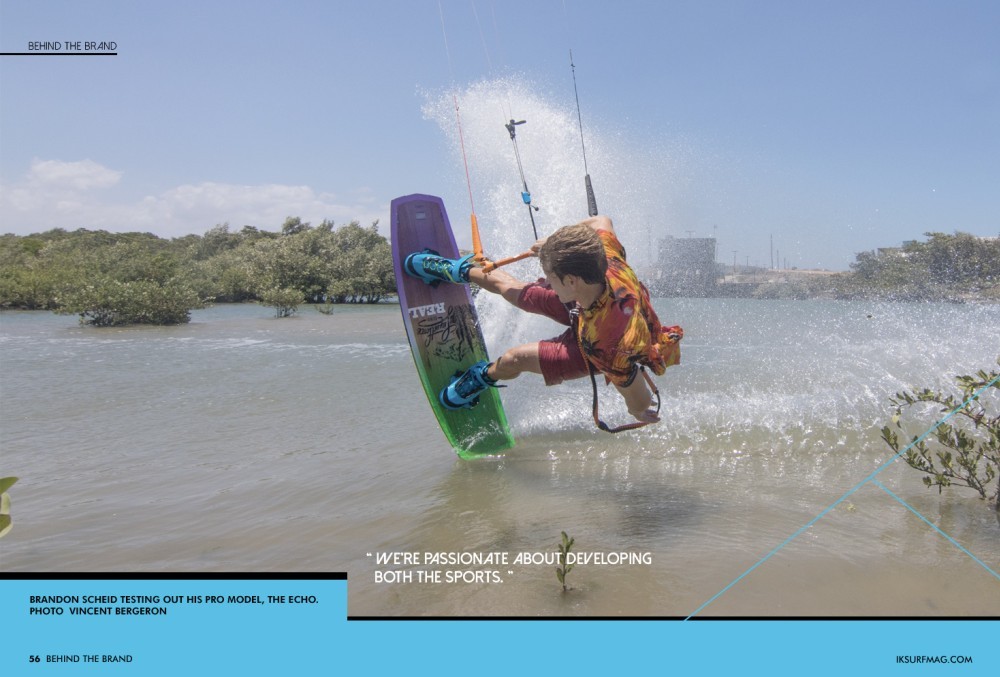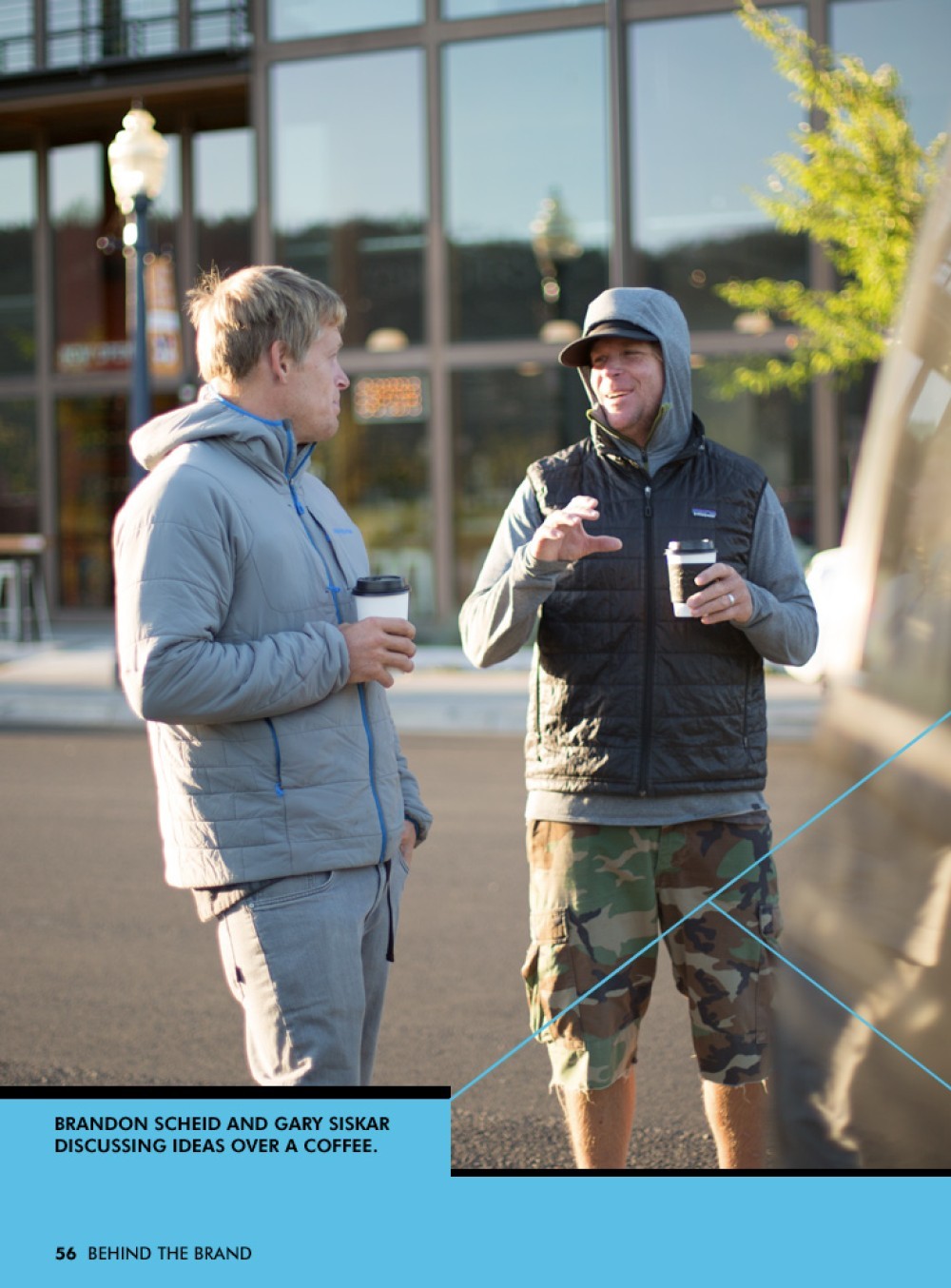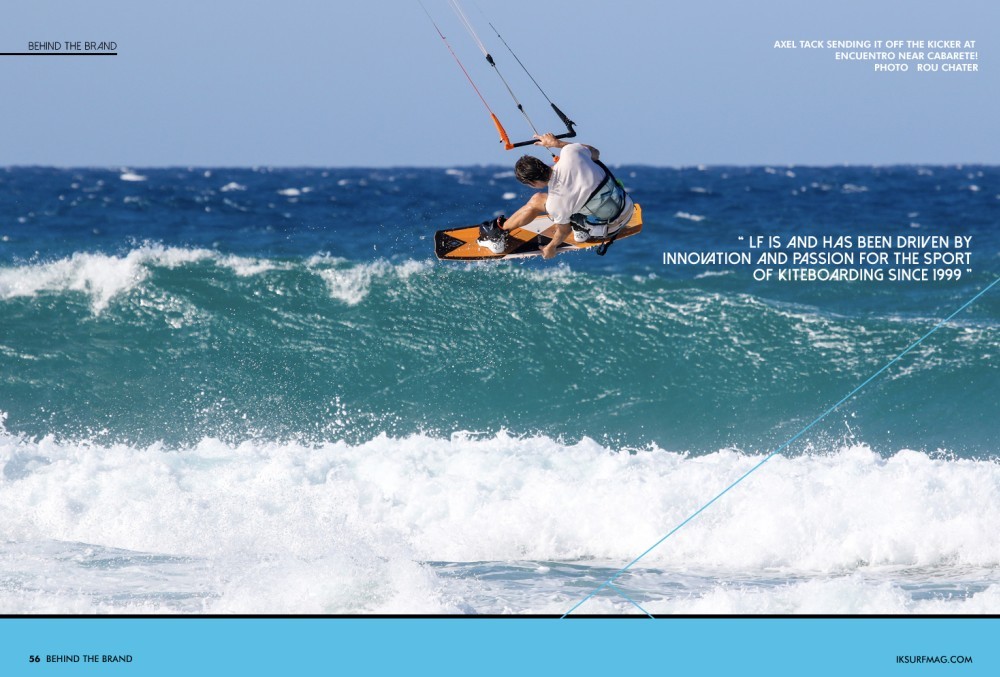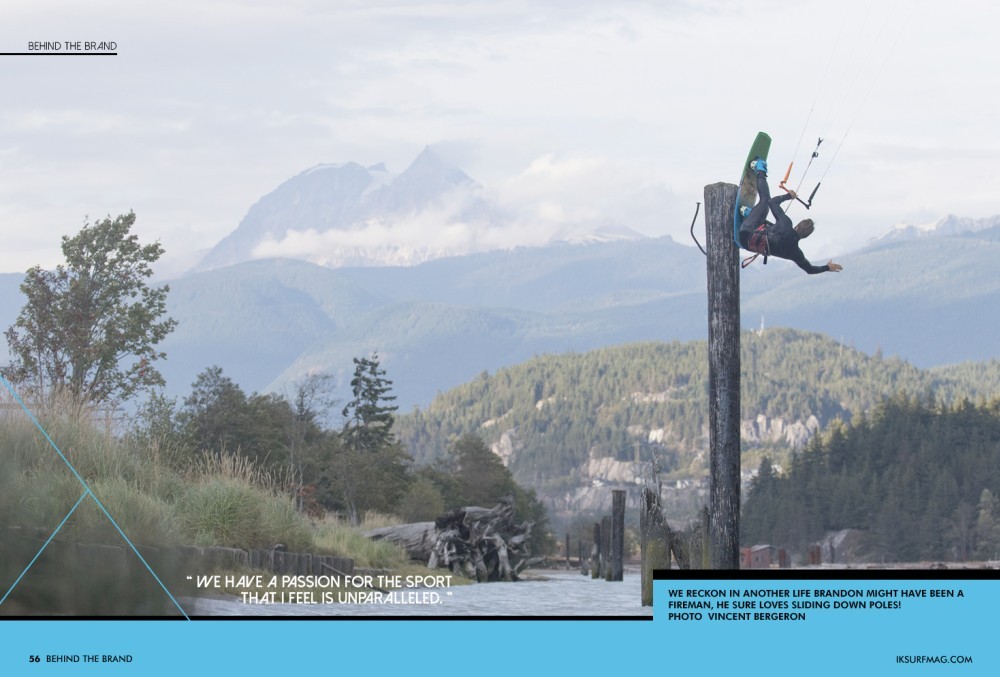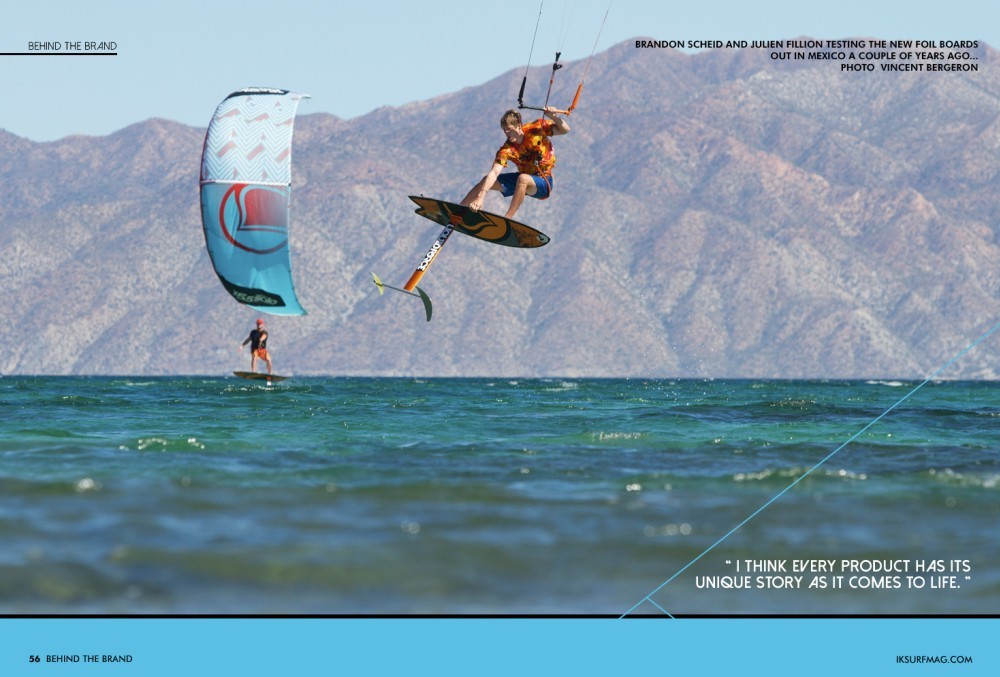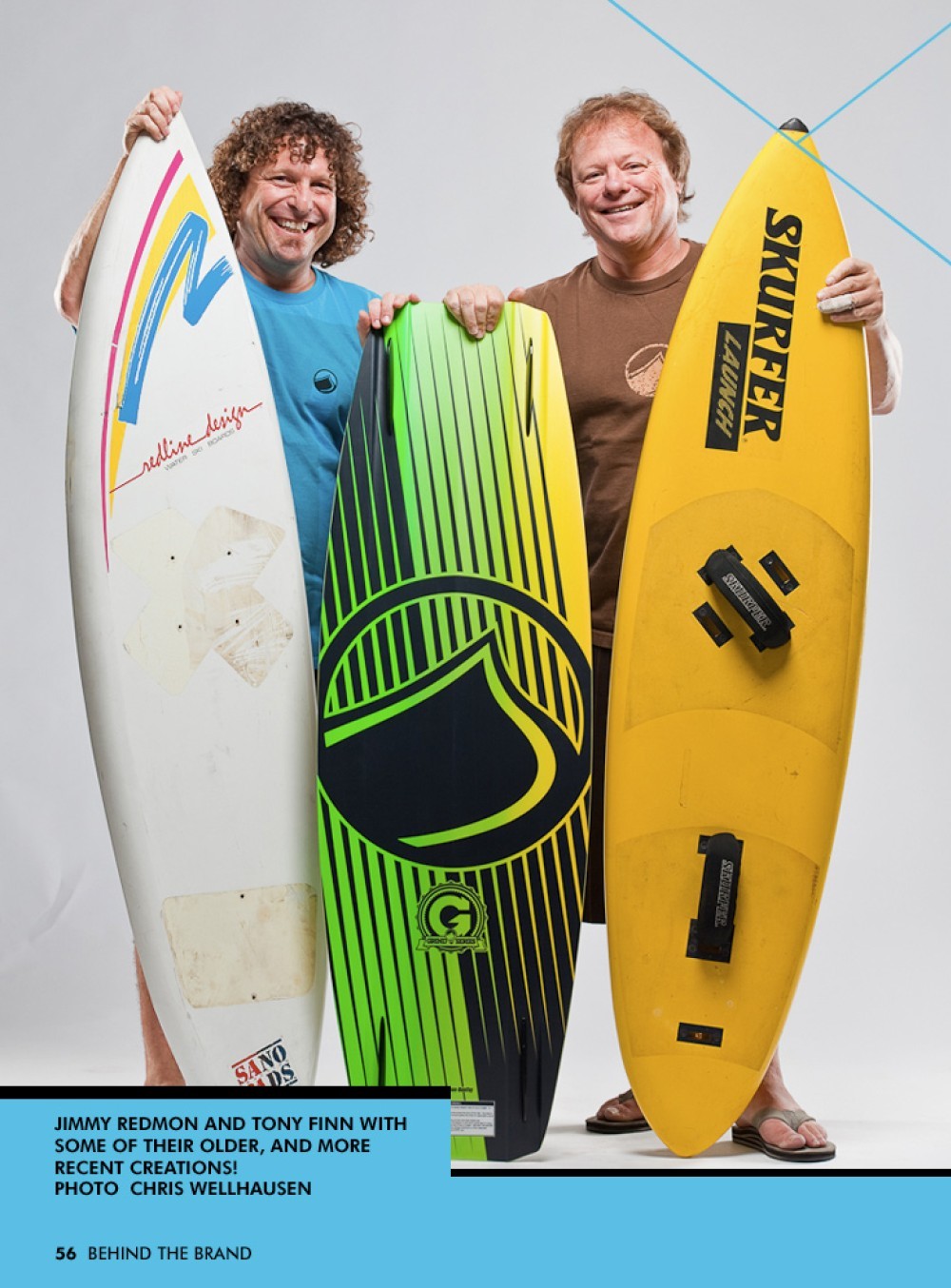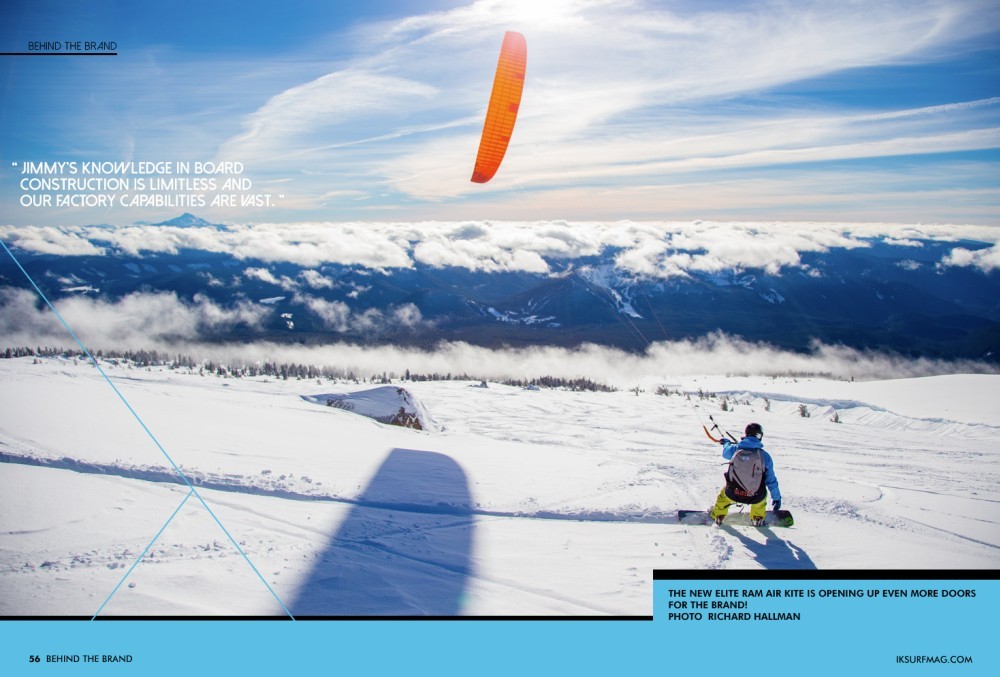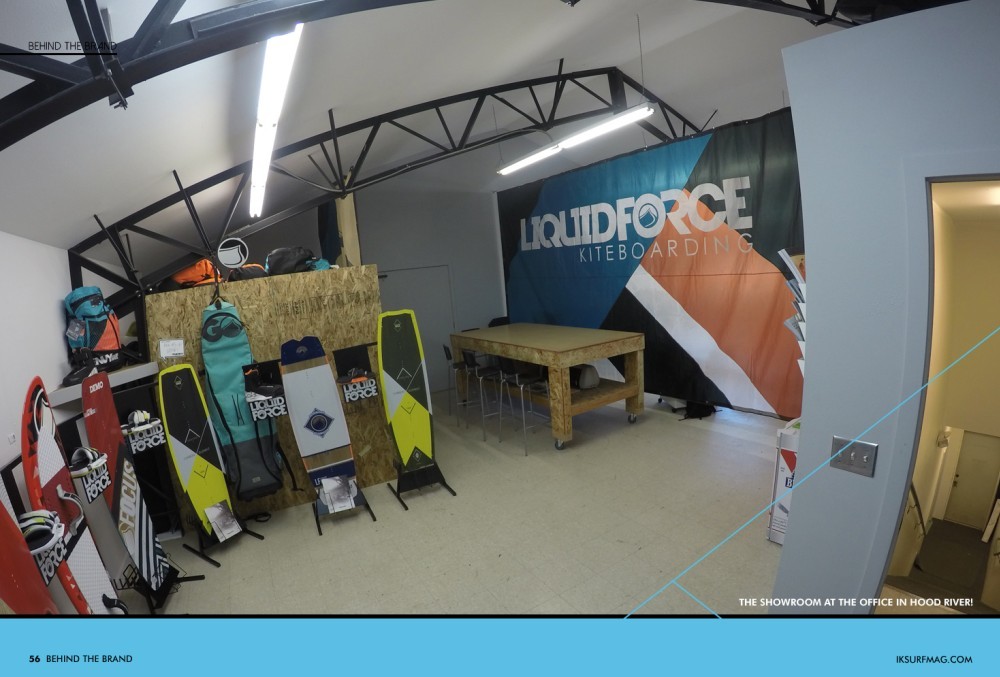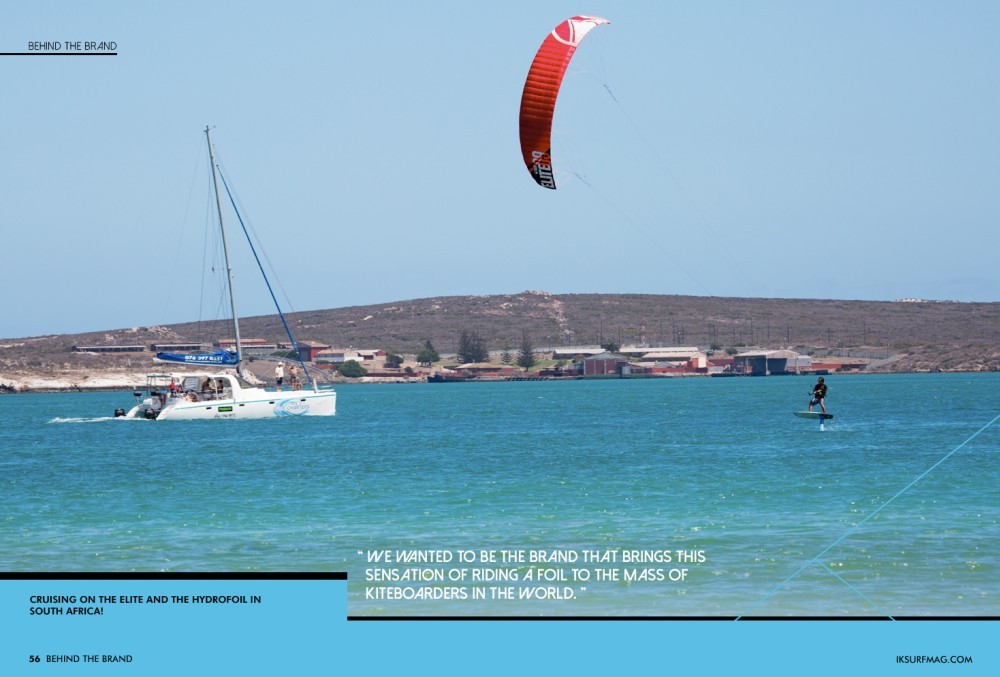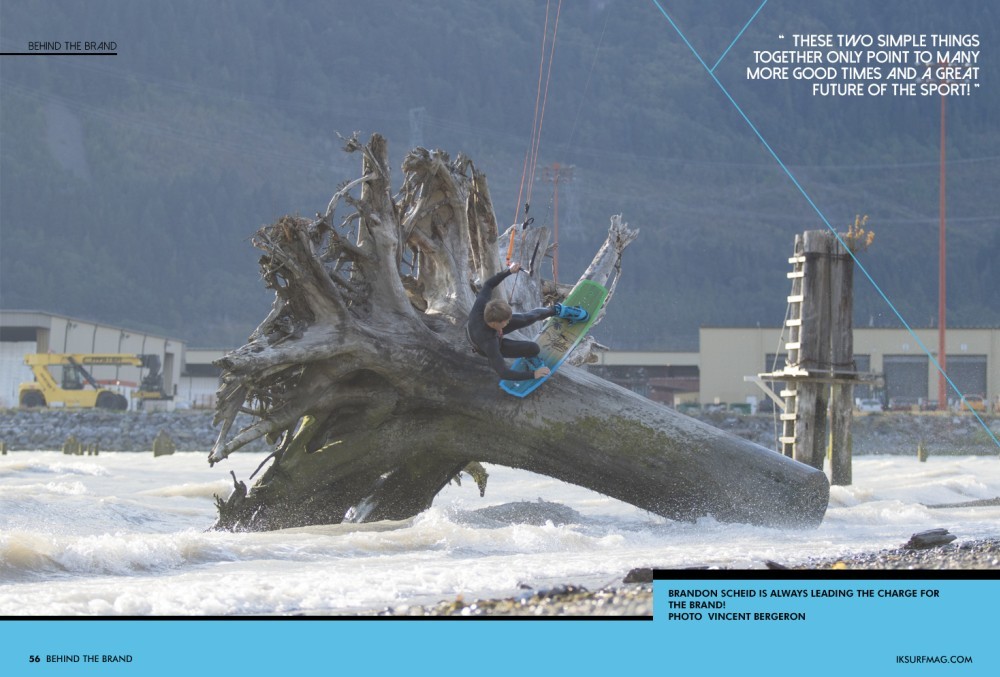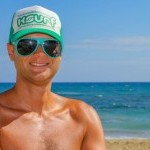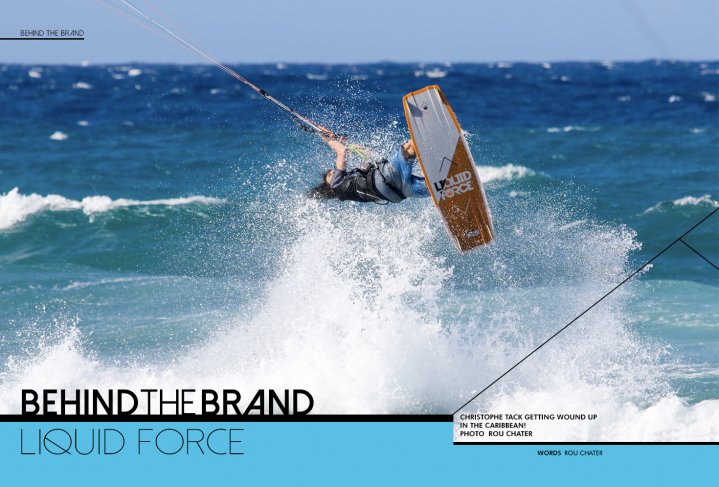
Behind The Brand - Liquid Force
Issue 56 / Sun 10th Apr, 2016
We catch up with Gary Siskar, Brand Manager for Liquid Force and ask him about their meteoric rise up the ranks in recent years and find out what goes on behind the scenes!
We sit down with Gary Siskar;Brand Manager at Liquid Force Kiteboarding to find out a little more about the seemingly unstoppable march the company is on. With a heritage that stretches back to before kitesurfing even existed, Liquid Force have stood the test of time and in recent years have been going from strength to strength!
Liquid Force, as a brand, is obviously steeped in wakeboarding history, can you give us a little back ground as to when you decided to branch out into kitesurfing and how that happened? Who were the founding fathers of Liquid Force Kiteboarding and are they still with you now?
Of course! We are very proud of our history in wakeboarding and the fact that LF Kiteboarding sprouted from the very talented people that started Liquid Force. Tony Finn and Jimmy Redmon founded LF. Tony was, and is to this day, a master motivator and deeply passionate personin the sport of wakeboarding. It’s thesame with kiteboarding and we’re passionate about developing both the sports.
Jimmy is a pure, outside of the box innovator, creator and craftsman that continues to this day shaping, programing and testing boards both for wakeboarding and kiteboarding. LF wake started in 1995 and the kite division sprouted in 1999. The spark that set off the idea for LF kite was a trip that Tony took to Maui in 1998. There he met Lou Wainman, Elliot Leboe, and Mauricio Abreu. These guys were (and some to this day still are) ripping on wakeboards and kiteboards shapedlike wakeboards.
From that day Tony had the vision and the dream to marry the 2 sports together. Starting at that time LF collaborated with many knowledgeable and talented individuals in kiteboarding, beginning with Jimmy Redmon connecting with Jimmy Lewis on the first production kite pickle fork board that released in 1998. Shortly after that LF teamed up with Wipika and created the Flight kite based off the Free Air in 1999, and from that day on Liquid Force became a reliable and innovative resource for kiteboarders around the world.
Where is Liquid Force Kites based currently, is there one central office or is the team spread out around the globe?
We are a truly global brand!Our central nervous system is now located in a new kite loft design space in Hood River, Oregon. This is where we administer all the sales, marketing and product line development. In addition to that we have offices in Encinitas, California, Montreal, Canada, and in Broger, Denmark. All of these locations add to the support of Liquid Force Kiteboarding from design and engineering to end consumer customer service. On top of all these locations our R&D team spends time where the wind is blowing at various times of the year which include Cape Hatteras in North Carolina, Mancora in Peru and of course the kiteboarding Meccas of Cape Town, South Africa and Maui, Hawaii.
The brand has changed a lot over the last 5 years, moving from one of the many players in the industry to rarefied heights as one of the major players in terms of the quality of the gear. How did that change come about and was it planned?
First off,thanks!! LF is and has been driven by innovation and passion for the sport of kiteboarding since 1999, but yes in the past 4 to 5 seasons (years) we feel like we have hit a new stride. We have focussed on bringing more relevant kiteboarding gear to product-hungry kiteboarders that matter! Making kites that suit particular styles of riding and a unique feel at the bar, the largest twin tip board line available and of course we have introduced products that have started revolutions in the market such as our hydrofoil line.
We also have also focused on teaming up with great retail and distribution partners worldwide that provide the highest level of brand experience and customer service. Was all this planned? Some yes and some no. In the end everyone at LF loves kiteboarding and we have a passion for the sport that I feel is unparalleled
You’ve recently changed your timeline for releasing new product, what was the thinking behind this?
Believe it or not this is a very complex question. In the past we would set a date of release for the entire season of product in late summer, early fall. We realised that this schedule was not favourable for our design and engineering team, the retailers and consumers. The fact is we don’t want to eliminate a current product that is working great just to release another product in the effort to outdate the current one.
Of course we have to have timelines and in the spirit of the retail world we have to push innovation and new ideas to market. Except now we let the designers and engineering team have more time to develop their ideas and innovations and allow for a significant time of testing both in a laboratory environment and also in the field. Along with this, our product is not becoming out dated in a single season. A retailer and end user can purchase an LF product with confidence that it wont be out dated in a short time span.
Tell us a little bit about the design teams, do you keep it separate for kites, boards and bars or does everyone have some input?
We have a very extensive design team around the world. We do have product leaders, for example in boards it’s Jimmy Redmon, and in kites and control systems Julien Fillion spearheads the design and development. Outside of these guys we do share design and engineering staff with the wake product team in Encinitas, California. Our “ace in the sleeve” is Jason Slezak that manages our R&D process. This process includes everything from him testing every product to managing our global test crew.
What’s the process for designing a totally new kite like the Solo for instance, how does that initial idea develop into a product on the shelves?
Whoa!! Big question. I think every product has its unique story as it comes to life. The Solo story is a good example of how we do give birth to a product. We really start off by looking at what we have in the line and how it is all working in the market. We ask ourselves first if we are content with what we have in the line and if there is anything that we personally want to see in the LF line up. This is all normally done after a session and having a few beers!
From there we start a complete concept and brief, this done in an office with a whiteboard. The Solo in particular started with all of us wanting a kite that was lightweight, easy to pack for travel, and possessed high performance expectations across all styles of riding. The next step is then handed off to Julien where he starts programing ideas and getting protos made for the testing process. After a complete battery of tests and signoffs the product becomes a reality for the rest of the world!
Do you go through many prototypes along the way and where do you do your testing?
For prototypes it varies. We have had kites like the Solo where we tested over 20 protos in a single size to arrive at the final kite. I would say on average we test in a single size, 6 to 10 protos. Then from there we have to prototype, adjust and test each size to achieve the same feel across the range of the model. For boards we have the same demanding protocol. We do have the ability with some very, very smart and passionate people in both Hood River and Encinitas to rapid prototype and field test parts! This has proven to priceless in our development process.
Liquid Force was known in the past as being a board brand at heart, but the older boards were always fairly heavy and stiff, with wakeboarding traits at their core. When did you decide to take things in a new direction, and how hard was it to implement?
This happened a while ago. Wakeboards were traditionally moulded construction boards. This was to create durability and the stiff flex needed to land flat if you missed the wake transition. But as the world turns new technology takes hold and the ability to produce a board with a laminated, wood core sandwich construction become relevant. Snowboard and ski technology was brought into the wakeboards to create new flex patterns for a smoother ride and as features such as rails, kickers and sliders came to play both at cable parks and behind a boat or PWC the flex control became more important.
For kiteboarding flex and construction offered benefits beyond what the wakeboard needs. Softer boards offered a smoother ride in chop. The use of CNC wood cores offered more precise channelling and bottom contours that allow for better upwind performance and softer jump landings in choppy water. For us it was not hard to implement. Jimmy’s knowledge in board construction is limitless and our factory capabilities are vast.
The surfboards have come on leaps and bounds in recent years, who's been working on the shapes and construction?
Ohhhhhhh, I can go on and on about this topic! Kite surfboards sit in an interesting category. I think every brand has been on a quest to satisfy an almost every request by the market in a kite surfboard. There are many types of kite surfers but the common goal that we are trying to achieve is a kite surfing board that rides like a traditional surfboard yet can stand up to the harsh use that kite surfers put the boards through.
Such as riding with straps and jumping, landing flat strapless, etc.…so the challenge is to get great working shapes that are not impacted by excessive weight or loss of flex due to the construction that is needed to hold up to the rigors of kiting. We actually took a year off introducing new kite surfboards into the market to take the time to develop and test a construction that will meet the challenges of kiting. What I can say now is that we have great surfboard shapes that incorporate surf rocker lines and volumes in a construction that is light, flexible and durable!
You were the first brand to mass produce a foil for the market place and foil boards now make up a large part of your range, who was the driving force behind taking the brand in that direction?
All of us in the brand were the driving force behind hydro foiling! We took a conscious stand more than 3 years ago that we would not make or get involved with a product or product category that we did not love to participate in ourselves. With hydro foiling we all fell in love from the first day of struggling to even get started on a hydrofoil. It was pure fun, after those first tries we knew that we wanted to make hydrofoils. And we knew that we wanted to be the brand that brings this sensation of riding a foil to the mass of kiteboarders in the world. We’re inclusive not exclusive!!!
How important was it to be the first to market with a mass produced foil board?
For us we just wanted to bring a price conscious product to the mass. The importance of being first was a passenger to just making the sport accessible cost wise to more people. We also wanted to bring a hydrofoil to market that the rider did not have to treat like a newborn baby. No, they are not indestructible, but yes, they will take more abuse than a 2800 custom carbon set up! Price conscious + easy to learn on + durable = lots of happy people that are now hydro foiling!
The price point was a huge step forwards for making foil boarding accessible, how did you go about achieving those goals of a low price of entry coupled with an effective and high quality foil?
Essentially we stepped outside the box of materials, looking to glass and aluminium, rather than the traditional carbon that had been favoured before. At least, that’s the short answer!
How difficult was it to keep up with demand? For a while there, those things were as rare as rocking horse sh!t...
Ha!! I am going to steal that line!! You are right…we did not expect the demand to be so great, and yeah…we had some catch up to accomplish!
Where do you see the future of that side of the sport headed?
I/we believe that we are just at the start of hydro foiling. What is great about the aspect of hydro foiling is that it touches every kiteboarder out there! What I mean by this is that you can race, freeride, and get out in light wind on a hydro. There are multiple branches to the hydrofoil tree as to where something like course racing is just a single stick. I also think that there is a great possibility of hydro foiling bringing in new kiteboarders! There are plenty of locations in the world that the wind is a steady 11/12/13 knots. This is where riding a hydro is amazing! Areas like San Diego, California go from 50 good kite days a year to 150 + days of kiting!
You've just launched a new kite, the Elite, which is a RAM air design, is this aimed at the race market and is that a direction you guys are headed or is it more of a freeride foil?
The Elite took 2 years in development between Julien Fillion and Benoit Tremblay of Concept Air along with many, many hours/weeks/months of testing with our test team and other ram air/para foil kiteboarders. This kite fell right into our design process. It was conceptualized around our hydrofoil program as we all saw the advantages of using a ram air kite, not just for racing, but also for freeriding with a hydrofoil. At the same time we did not want to pigeon hole the kite in a “race” category.
The Elite works great across all surfaces of riding were a ram air could add free ride performance. Snow and land being the other two. Another goal of the Elite is ease of use. We believe that the Elite is one of the most user-friendly ram airs on the market in terms of ease of launching, re-launch and stability in the air cells. Can you race and win with an Elite? We would say yes as it has been proven to reach the podium on snow, while at the same time you can gain the advantage of a ram air for cross surface freeriding!
Where are you getting the foil built? Obviously the process for making foil kites is very different from LEI's, have you had to make special considerations regarding this?
The Elite is constructed in the same factory as our LEI kites. They have made foil kites since the start of kiteboarding and the attention to detail and knowledge is there.
The brand has grown a lot over the last fiveyears; do you think the rise of wakestyle riding has helped with your credibility in the market place?
We have always been credible in the wakestyle arena! With past team riders like Mauricio Abreu, Moehau Goold, John Romais, Joby Cook, Craig Cunningham and our current wake squad of Jason Slezak, Brandon Scheid, Sensi Graves, Rich Sabo, Christophe Tack, and Jan Schiegnitz, Alex Campet, and many others. We deeply support all the “wake style” events with the Triple S, Hood River Slider Jam, Blue Palawan, Rider 4 Rider, Russian Rail Masters, and we are dedicated to the “Slider Project”. We are not just committed to the wake movement in kiteboarding it is in our DNA. (How is that for name-dropping?) It’s been great to see this side of the sport grow over the last few years and we are really proud to have always been a part of it!
You've got a plethora of solid riders on your team, how important are these guys and girls to the brands success, and how do you go about choosing the team riders?
Team is an important part of the LF family. Any sport needs aspirational people involved at all levels. Figuring out if a rider fits our program or not is actually difficult. There are so many good riders out there putting it on the line. But we know that putting it on the line is just one aspect. We love riders that are personable, nice on the beach, and setting a great example. Connection to a retailer, distributor or lesson centre is critical to us. And of course they need to be able to project the brand in a positive light by helping generate brand exposure.
You won a World Championship with Christophe Tack, who last year decided not to compete on the debacle that was the VKWT, in hindsight that now looks like a good move> What’s your standpoint on the current state of the competition scene as a brand with riders who are affected by some of the decisions being made?
Every sport in my opinion, to be legitimate, needs a competitive component that is recognized at a global level. It is sad to see that the competitive organization for kiteboarding is just mired in what seems to be mismanagement, controversy and poor judgment. I will say that I don’t know the ins and outs or the full story; it is just my outside perception. I just hope, and wish it would shake itself out and become organized. Tack won what I consider to be the last true World Championship (ohh I can see the hate mail coming my way now!)… As for Tack taking a break from the tour, we fully support his decision to do what he feels will push him to the next level. And the next level is on the way.
Do you see more of a future in the standalone competitions like the Triple S and the King Of The Air or do you think we need a world tour?
Bring all of it on! The more the merrier! All these events give riders a way to express themselves. The Triple S has launched and supported some pro kiteboard careers! And now that “style” of event is taking shape in other regions such as Russia, Philippines, and Austria. The King Of The Air - can there be another?!?! I don’t know. That event is big at so many levels and is amazing on so many levels. This year was the first year that I was able to attend and be a spectator and being there in person is next level mind blowing.
First, the number of people there to watch, the event exposes kiteboarding to thousands! Then you take the athletes, these guys put their life on the line -literally(Lewis you are the king!!). It is an event that is of epic proportions. Can there be another King Of The Air? Like I said, I don’t know…but I would love to see some other events grow to that magnitude of exposure for kiteboarding. And as I stated in the last question, yes there needs to be a competitive world tour to crown a World Champion. It does not need to be ten stops, just a tour. Three or four to get it back on track. Make it understandable for a spectator. Proliferate media to expose kiteboarding to a larger audience, and take care of the riders so they are motivated to participate and have a future in the sport!
Who is Meerkite and what is his role within the brand?
Meerkite! Ohh yeah! Meerkite is Meerkite. I really don’t know, but we sure love him as he sure loves LF and everyone in LF. He does have some love for others, however we don’t hold that against the little furry fella… We did reach out to discuss a deeper relationship and endorsement program, but he just said “nah, I like rolling how I roll and I am going to keep on roll’n” and that is that! High fives to the Meerkite for staying true!
What's the future for Liquid Force Kites and where do you see the sport headed?
What is up with this typical last question? We could have just ended with Meerkite! Or we can just dedicate an entire issue to the second part of where the sport is headed! Anyway, Liquid Force has a great future. We are just at 17 years of kiteboarding history and Liquid Force is here to stay. As we say we are just a minor threat, if you want to believe that or worry about it, it is your choice! As for where the sport is headed, this is easy - kiteboarding is blast and very addictive, these two simple things together only point to many more good times and a great future of the sport! Let’s get more people into it!! There is plenty of wind and space on the water, snow and land for all!
Videos
By Rou Chater
Rou has been kiting since the sports inception and has been working as an editor and tester for magazines since 2004. He started IKSURFMAG with his brother in 2006 and has tested hundreds of different kites and travelled all over the world to kitesurf. He's a walking encyclopedia of all things kite and is just as passionate about the sport today as he was when he first started!




